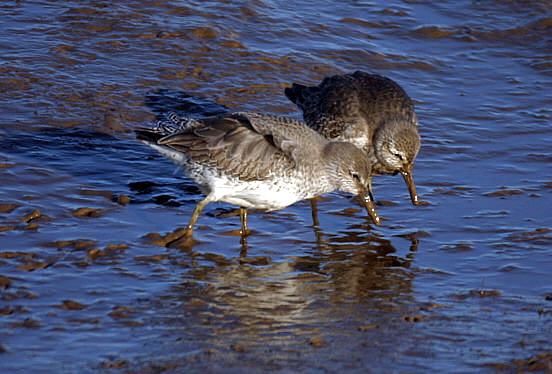Red Knot (Calidris canutus) - wiki Red Knot
From Wikipedia, the free encyclopedia
[Photo] Winter plumage Red Knot feeding. Image taken by Andrew Easton at Breydon Water, UK, 30th December 2004. http://en.wikipedia.org/wiki/User:A.C.Easton
The Red Knot, Calidris canutus (just Knot in Europe), is a medium sized shorebird which breeds in tundra in the far north of Canada, Europe and Russia.
There are six subspecies, in order of size;
C. c. roselaari (largest)
C. c. rufa
C. c. canutus
C. c. islandica
C. c. rogersi
C. c. piersmai (smallest)
North American birds winter in coastal areas on the Atlantic and Pacific coasts as far south as Argentina as well as to the British Isles. Old World birds migrate to Africa, Papua New Guinea, Australia and New Zealand (see distribution map). This species forms enormous flocks in winter.
The Red Knot nests on the ground, near water, and usually inland. The female lays 3 to 4 eggs in a shallow scrape lined with leaves and moss. Both parents incubate the eggs, but the female leaves before the young fledge. After the young have fledged the male begins his migration south and the young make their first migration on their own.
An adult Red Knot is 23-26 cm long with a 47-53 cm wingspan. It has short dark legs and a medium thin dark bill. The body is mottled grey on top with a cinnamon face, throat and breast and light-coloured rear belly. In winter the plumage becomes uniformly pale grey. canutus, islandica and piersmai are the “darker” subspecies. rogersi has a lighter belly than either roselaari or piersmai, and rufa is the lightest in overall plumage.
The weight varies with subspecies, but is between 100 and 200 g. Red Knots can double their weight prior to migration.
On the breeding grounds, Knots eat mostly spiders, arthropods, and larve obtained by surface pecking, and on the wintering grounds they eat a variety of hard-shelled prey such as bivalves, gastropods and small crabs that are ingested whole and crushed by a muscular stomach.
It is sometimes said that the Red Knot gets its name from King Cnut, but there is no factual basis for this story. A more likely etymology is that the name is onomatopoeic, based on the bird's grunting call note.
C.c.canutus and C.c.islandica are among the subspecies to which the Agreement on the Conservation of African-Eurasian Migratory Waterbirds (AEWA) applies.
Threats to the American subspecies (C. c. rufa)
Near the end of the 19th century, large numbers of Knot were shot for food during migration in North America. More recently, the birds have become threatened as a result of extensive commercial harvesting of horseshoe crabs in Delaware Bay which began in the early 1990's. Delaware Bay is a critical stopover point during spring migration; the birds refuel by eating the eggs laid by these crabs, and with reduced numbers of horseshoe crabs living in the bay there are fewer eggs to feed on.
In 2003, scientists projected that at their current rate of decline the American subspecies might go extinct as early as 2010. Several environmental groups have petitioned the U.S. government to list the birds as endangered, but thus far their requests have been denied. In New Jersey, state and local agencies are taking steps to protect these birds by limiting horseshoe crab harvesting and restricting beach access. In Delaware, a two-year ban on the harvesting of horseshoe crabs was enacted but struck down by a judge who cited insufficient evidence that the ban would help restore the Red Knot's numbers to justify the potential disruption to the fishing industry.
http://en.wikipedia.org/wiki/Red_Knot
| The text in this page is based on the copyrighted Wikipedia article shown in above URL. It is used under the GNU Free Documentation License. You may redistribute it, verbatim or modified, providing that you comply with the terms of the GFDL. |
